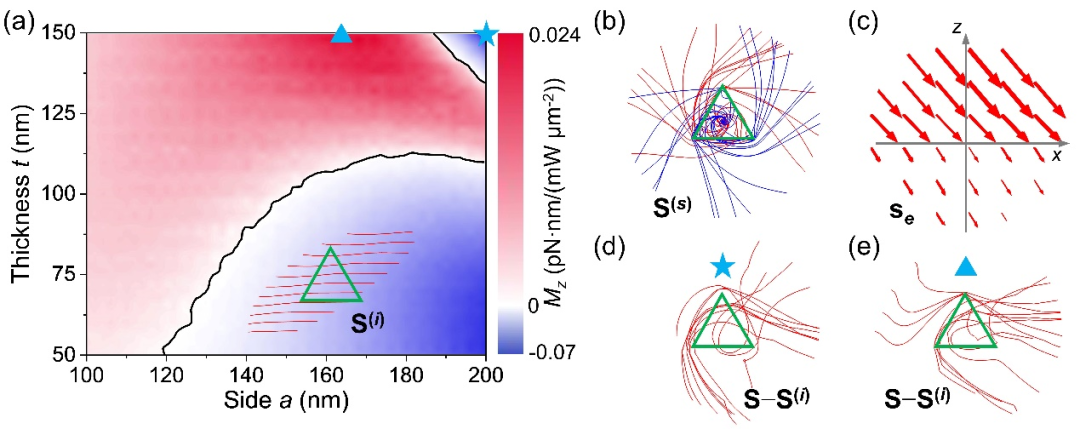Recently, professor Yuzhi Shi from professor Xinbin Cheng's team at the School of Physical Science and Engineering, Tongji University, in collaboration with Singapore Academician Ai Qun Liu from Nanyang Technological University in Singapore, Professor Din Ping Cai from the City University of Hong Kong, Academician C. T. Chan from the Hong Kong University of Science and Technology, and Professor Cheng-Wei Qiu from National University of Singapore, have published a paper entitled "Inverse Optical Torques on Dielectric Nanoparticles in Elliptically Polarized Light Waves" in Physical Review Letters. The paper is the first to investigate inverse optical torques in nonmetallic nanoparticles in elliptically polarized light waves, and reveals the mechanism of different polarization states on optical torques.

Research Highlights
Optical tweezers have received a great deal of attention because they use non-invasive optical forces to manipulate tiny particles. And optical torques generated by the angular momentum of light also play a crucial role in this process. The optical torques are used in a wide range of applications in physics, biomedicine, and chemistry, including quantum photomechanical systems, tribology, torsional measurements of biomolecules, and the construction of micro stirring motors. Normally, a particle in circularly polarized light produces an optical moment in the same direction as the spin angular momentum. The "negative optical torque", which is in the opposite direction of the spin angular momentum, has recently been found in systems such as metal chiral particles, phase hysteresis disks, and particle clusters. However, due to the dipole model, the "negative optical torque" has not been found in a single individual nonmetallic particle. This research team discovered the "negative optical torque" in dielectric triangular prisms for the first time by using obliquely incident elliptically polarized light, and revealed the action mechanism of the effect of different polarization states on the moment in the triangular prism structure, as shown in Figure 1.

Figure 1: An elliptically polarized light at oblique incidence excites an inverse moment in a triangular prism. Triangle orientation Angle and the polarization of light can have strong effects on the inverse optical torque.

Figure 2: Influence of the ellipsometry of the light, particle size, and refractive index on the inverse optical torque.
The team attributed the "negative optical torque" to the asymmetric distribution of dipoles of the particles under different polarizations of elliptical polarization decomposition such as p-polarization excitation, while the decomposition of the s-polarization and spin angular momentum of elliptical polarization always cause the "positive optical torque". At the same time, the team found that the "negative optical torque" is closely related to the elliptical polarization, particle size and refractive index, as shown in Figure 2. The closer that light tends to be p-polarized, or the higher the refractive index of the particle, the easier to excite the "negative optical torque". On the contrary, the absorption of the particles will produce a "positive optical torque", which will weaken the "negative optical torque". The size of the particle, including the side length and thickness of the triangle, can also have a great impact on the optical torque, as shown in Figure 3.

Figure 3: Effect of particle size on optical torque.
The team also found that the "positive optical torque" and "negative optical torque" can be easily switched by simply adjusting the incident angle of light. This "negative optical torque" will cause the particle to be freezed in conventional particle rotation experiments, thus affecting the performance of relevant experiments, as opposed to conventional experiments that use a light field with spin or orbital angular momentum to rotate the particle. This research reveals, for the first time, the effect of elliptically polarized light at different oblique incidence on light torques on dielectric particles, providing important applications in the fields of light-matter interaction, biophysics, etc.
Dissertation Information
Professor Yuzhi Shi, School of Physical Science and Engineering, Tongji University, is the first author and co-corresponding author of the paper; Professor Xinbin Cheng as the team leader, participates in the research; Academician Ai Qun Liu, Nanyang Technological University, Singapore, and Professor Cheng-Wei Qiu, National University of Singapore, are co-corresponding authors of the paper. The research was supported by the Fundamental Research Funds for the Central Universities.
Link to the paper:
https://link.aps.org/doi/10.1103/PhysRevLett.129.053902
